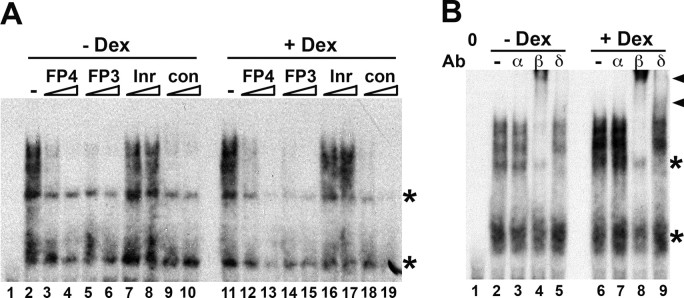Fig. 4.
C/EBPβ in A549 Cells Binds to the Glucocorticoid-Responsive Region of the 11β-HSD1 P2 Promoter
A, Representative competition EMSA showing complexes formed by A549 nuclear extracts on a double-stranded oligonucleotide encoding FP4 (0.1 pmol). Lane 1 contains no added protein. Lanes 2 and 11 contain 4 μg nuclear extract from vehicle-treated (−Dex) and dexamethasone-treated (+Dex; 10−6 m, 24 h) cells, respectively. Addition of competitor oligonucleotides (5- or 50-fold molar excess) is indicated above the lanes. Oligonucleotides encoded FP4, FP3, the TdT initiator (Inr; to which C/EBP does not bind) (26 ), and a C/EBP consensus binding site (con) described previously (26 ). B, Representative EMSA showing presence of C/EBPβ and C/EBPδ, but not C/EBPα, in complexes formed by 4 μg nuclear extract from vehicle (−Dex) or dexamethasone (+Dex; 10−6 m) treated A549 cells on a oligonucleotide encoding FP4. The addition of C/EBPα (α), C/EBPβ (β), C/EBPδ (δ), or no (−) antibody is indicated above the gel. The C/EBPβ/δ supershifted complex is indicated by a black arrowhead. The first lane does not contain any added protein extract. Nonspecific complexes are indicated by asterisks.

